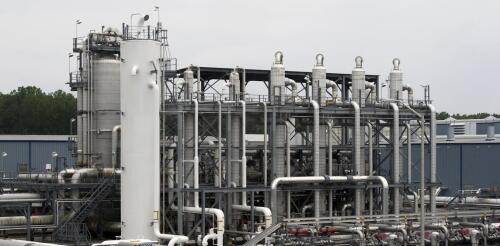environment
Flowers grown on inexpensive floating platforms can help clean polluted waterways, over 12 weeks extracting 52% more phosphorus and 36% more nitrogen than the natural nitrogen cycle removes from untreated water, according to our new research. In addition to filtering water, the cut flowers can generate income via the multibillion-dollar floral market. In our trials of various flowers, giant marigolds stood out as the most successful, producing long, marketable stems and large blooms. Their yield matched typical flower farm production. Why it matters Water pollution is caused in large part by runoff from farms, urban lawns and even septic tanks. When it rains, excess phosphorus, nitrogen and other chemicals wash into lakes and rivers. These nutrients feed algae, leading to widespread and harmful algae blooms, which can severely lower oxygen in water, creating “dead zones” where aquatic life cannot survive. Nutrient runoff is a critical issue as urban areas expand,...
In dozens of archaeological discoveries around the world, from the once-successful reservoirs and canals of Angkor Wat in Cambodia to the deserted Viking colonies of Greenland, new evidence paints pictures of civilizations struggling with unforeseen climate changes and the reality that their farming practices had become unsustainable. Among these discoveries are also success stories, where ancient farming practices helped civilizations survive the hard times. Zuni farmers in the southwestern United States made it through long stretches of extremely low rainfall between A.D. 1200 and 1400 by embracing small-scale, decentralized irrigation systems. Farmers in Ghana coped with severe droughts from 1450 to 1650 by planting indigenous African grains, like drought-tolerant pearl millet. Ancient practices like these are gaining new interest today. As countries face unprecedented heat waves, storms and melting glaciers, some farmers and international development organizations are rea...
Tens of millions of Americans, including many Texans like me, live in counties that will soon be violating air pollution particle standards for the first time. It’s not that our air is getting dirtier – it’s because the U.S. Environmental Protection Agency just tightened its cap on the deadliest air pollutant: fine particulate matter, or PM2.5. The EPA acted because the Clean Air Act requires it to periodically review existing standards for six major air pollutants to ensure that the targets protect public health. Its 2022 scientific review showed that fine particles increase rates of illnesses and death even when inhaled at levels below existing standards. The EPA estimates that meeting its new standard would yield up to US$77 in health benefits for each $1 of control costs and would save up to 4,500 lives in 2032. Now, states must develop plans that meet the standard. As an atmospheric scientist who has studied air pollution for a quarter century, I’...
Curious Kids is a series for children of all ages. If you have a question you’d like an expert to answer, send it to curiouskidsus@theconversation.com. Why does a leap year have 366 days? Does the Earth move slower every four years? – Aarush, age 8, Milpitas, California You may be used to hearing that it takes the Earth 365 days to make a full lap, but that journey actually lasts about 365 and a quarter days. Leap years help to keep the 12-month calendar matched up with Earth’s movement around the Sun. After four years, those leftover hours add up to a whole day. In a leap year, we add this extra day to the month of February, making it 29 days long instead of the usual 28. The idea of an annual catch-up dates back to ancient Rome, where people had a calendar with 355 days instead of 365 because it was based on cycles and phases of the Moon. They noticed that their calenda...
The Biden administration has frozen pending decisions on permit applications to export liquefied natural gas, or LNG, to countries other than U.S. free trade partners. During this pause, which will last for up to 15 months, the administration has pledged to take a “hard look” at economic, environmental and national security issues associated with exporting LNG. Environmental advocates, who have expressed alarm over the rapid growth of U.S. LNG exports and their effects on Earth’s climate, praised this step. Critics, including energy companies and members of Congress, argue that it threatens European energy security and energy jobs in the U.S. Emily Grubert, associate professor of sustainable energy policy at the University of Notre Dame and a former official at the U.S. Department of Energy, explains why large-scale LNG exports raise complex questions for U.S. policymakers. Is the US a major LNG supplier? The U.S. is now the world’s largest LNG exporter...




